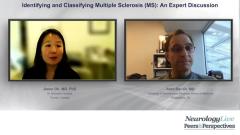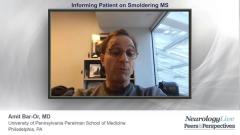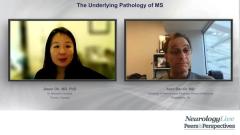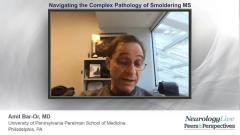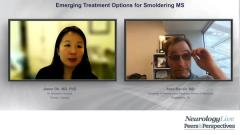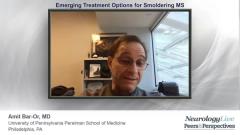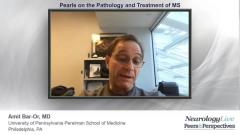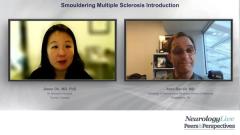
The Underlying Pathology of MS
Experts describe our current understanding of the pathology of multiple sclerosis (MS).
Episodes in this series

Transcript
Jiwon Oh, MD, PhD: You mentioned a ray of hope, potential new treatments, but before we get to that, I’m just going to segue into talking a little bit more about underlying mechanisms of smoldering MS [multiple sclerosis]. But before we do that, and you’ve already alluded to this to me, but can you just summarize for our audience what contributes to underlying disease worsening or disability progression in MS as a whole? And then we’ll talk more about smoldering MS.
Amit Bar-Or, MD: [S]o there are, again, 2 different processes that can contribute to injury over time of the central nervous system [CNS]. One, again, is the relapse biology. And we think that reflects the activation of immune cells outside of the [CNS] that then traffic and infiltrate around vessels, causing what we refer to as perivascular inflammation. And the imaging counterpart will be the development of a new gadolinium-enhancing lesion and new T2 lesion. And that these reflect focal inflammation as the consequence of relapse biology. And that of course these lesions leave some injury, and they will potentially contribute over time to people getting worse neurologically. And certainly, there are some relapses that quite clearly don’t improve back to baseline. And that stepwise worsening, which is something we try to gauge as we ask patients about their experience since the last visit. And if you’re worse, do you remember if that happened over days to a couple of weeks or did it really seem to be just building up very gradually over time? So the relapse biology is one relapse contribution to worsening disability and part of the unfortunate terminology is people talk about progression of disability, which of course is something that may reflect worsening either from relapses that don’t get better or this other nonrelapsing biology, the second biology, which we think rather than representing new waves of immune cells infiltrating from the outside into the [CNS], [it] represents now one or more processes that are compartmentalized within the [CNS]. Part of that is likely to reflect inflammation that sets up shop within the [CNS] and then there are other mechanisms that we can expand on that are likely also contributing together to the overall smoldering aspect of MS.
Jiwon Oh, MD, PhD: Thank you, and as you said earlier, I think we’re very fortunate as a field because we have some excellent treatments that do a really good job of controlling the relapse biology and it’s clear that our current treatments probably don’t do a very good job at controlling the nonrelapse disease biology, which is why it’s very clear that this is the real unmet need in the field and why so many efforts are being poured into trying to better understand nonrelapse disease biology or compartmentalized inflammation. Speaking of which…you mentioned that compartmentalized inflammation and chronic lesions contribute to smoldering MS, but could you give us a general overview of the different processes that contribute to nonrelapse disease biology.
Amit Bar-Or, MD: Sure, so on one hand we have those focal lesions that we mentioned start as part of relapse biology. There are other regions of the [CNS] that seem to be involved in a more smoldering injury process. One of these is the subpial cortical injury, which reflects these bands of demyelination that appear to be happening sort of from the surface in along the cortical ribbon and subjacent to the pia and meninges adjacent to the CSF [cerebrospinal fluid] and one can see a similar pattern of graded injury also in periventricular structures like the thalamus, the side of the thalamus that is facing the ventricles. Now, interestingly, the pathologists have been teaching us that there’s inflammation in the meninges and in the ependyma and the presence of such immune cell infiltrates that seem to set up shock within these structures, the meninges and the ependyma, have been associated with the presence of these regions of demyelination where there’s also neuronal loss and microglial activation, and the presence and the extent of these have been well correlated with both cognitive and physical progression of disability. So that is one aspect of the pathology that we think is contributing to smoldering injury and these are not as easy to visualize in standard imaging kind of techniques. The other that is quite exciting is the appreciation that while many of the focal inflammatory lesions that develop as part of relapsed biology may settle down and no longer be active, a subset of them seem to have a second life and that second life pathologists have described as chronic active or also called active-inactive lesions. We now have a couple of imaging modalities that seem to be able to capture at least some of these chronic active lesions. One is referred to as slowly expanding lesions and if you have 2 images over time, and even with relatively standard imaging approaches, you’re able to capture some changes in the size of a lesion that had previously formed as part of relapsed biology, but its second life is involving some expansion. And we think that reflects some aspect of chronic lesions. The other is that the pathology of chronic active lesions may involve a rim of cells, likely microglial cells of the CNS that gobble up iron and hence have an iron signal. They are then identifiable as paramagnetic rim lesions or pearls as they’ve been described. So slowly expanding lesions are the cells and paramagnetic rim lesions are the pearls. And these 2 modalities are for the first time giving us some handle on this aspect of nonrelapsing progressive biology in vivo in patients and are modalities that are increasingly being used in new clinical trials and of great interest for new emerging therapies for progressive MS.
Jiwon Oh, MD, PhD: Thank you.
Transcript was AI-generated and edited for clarity.
Newsletter
Keep your finger on the pulse of neurology—subscribe to NeurologyLive for expert interviews, new data, and breakthrough treatment updates.

